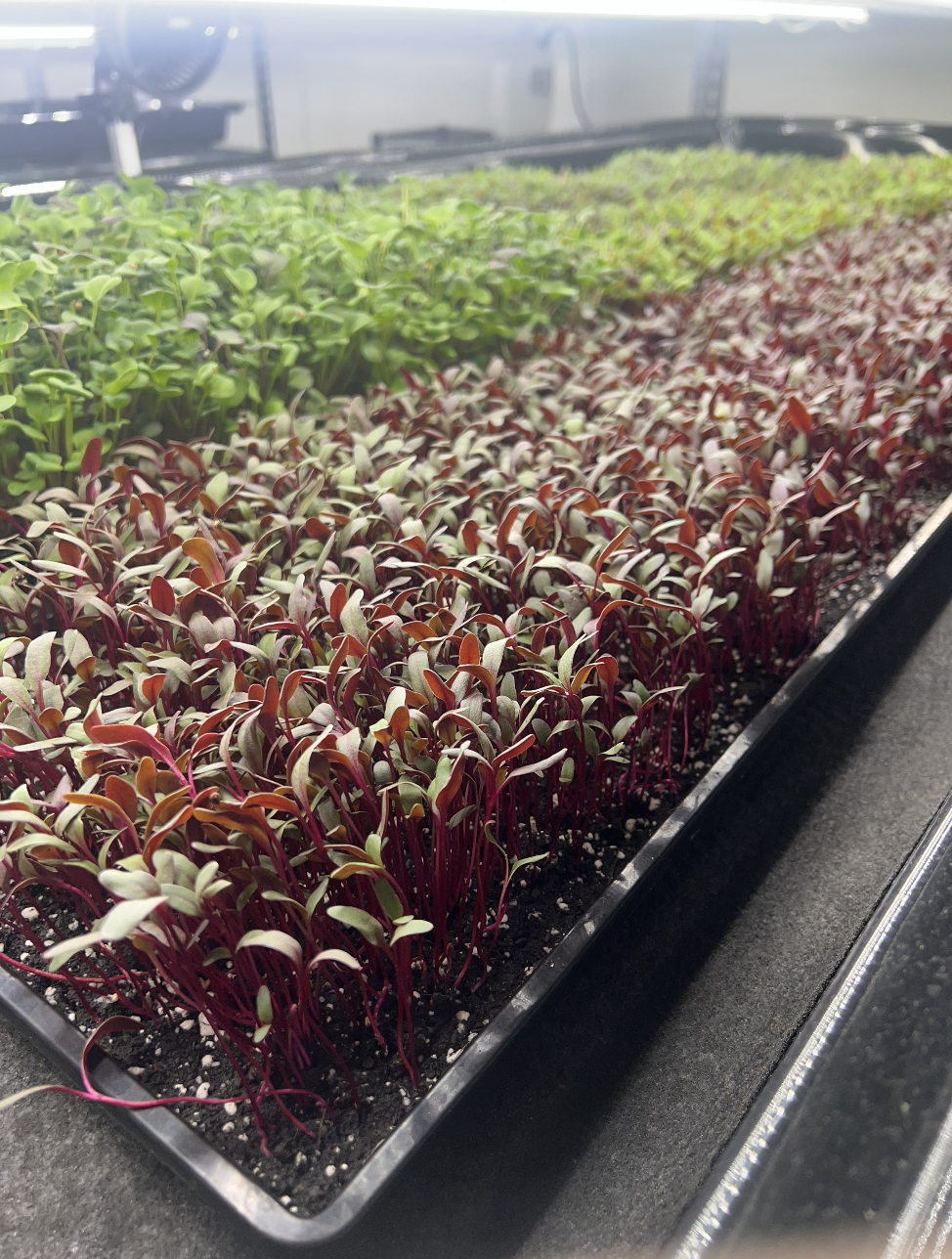
By Pamela B. Steele, CNC; Friends of Hardee Greens Farm
Nutritional Benefits of Microgreens
The nutrient quality of our grocery store produce is compromised by many factors:
Long lead times from harvest to consumption
Petroleum containing preservative coatings
Gut damaging pesticides and chemicals
Organically grown microgreens are a powerful tool to boost daily nutrient intake of vitamins, minerals and fiber.
Organically grown microgreens are a powerful tool to boost daily nutrient intake of vitamins, minerals and fiber.
Insulin Resistance Supportive
Brain Function Enhancing
Heart Health Improving
Cancer Preventative
Vision Protective
Anemia Reducing
Registered Dietitian Kayla Kopp MS RD describes microgreen nutritional benefits as such:
-
The nutritional benefits of each type of microgreen depend on the plant. But research shows that microgreens may contain 4 to 40 times the nutrients of mature plant leaves.
-
Microgreens deliver big flavor in small servings and provide more concentrated nutrients than their full-grown counterparts; adding them to your favorite dish can take a balanced diet to the next level.
-
As a bonus, many of the nutrients in microgreens act as anti-oxidants, with the power to prevent cell damage. To prevent excess cell damage is to prevent disease, inflammation and pain. These health benefits alone make microgreens worthy of a closer look.
Here is a glimpse of the nutrition profile of selected Hardee Greens microgreens:
Beets: Beet microgreens are packed with Vitamins A, B6, K and C and minerals such as: Calcium, Iron and Potassium. Beet microgreens have many benefits to overall health including heart, eye health and immunity. They are anemia, cancer and osteoporosis fighting and hair, skin and nail growth supporting,
Mustard: Mustard microgreens are rich in Vitamins A, C and K as well as Calcium and Iron. Mustard microgreens detoxify the liver and help type 2 diabetics regulate blood sugar. In addition, they support immunity, hair/skin/nail health and tackle sinus congestion.
Mizuna: Mizuna microgreens are packed with Vitamins A,C and K and Calcium. Mizuna is high in cancer fighting antioxidants. They support proper blood clotting, eye health and strengthen bones. Once cup of Mizuna microgreens provides three times the daily requirement for Vitamin K which is essential, along with Calcium, for healthy bone formation.
Basil: Basil microgreens are rich in Vitamins A, C, E, K and B complex and essential minerals like Potassium, Calcium and Iron. They are known for their cancer fighting antioxidant/anti-inflammatory properties and enhancement of cardiovascular health. Medicinally, basil microgreens are used to aid digestion, alleviate coughs and colds, and reduce stress and anxiety. They are also eye health supportive and anti-microbial, helping heal wounds and fight infections.
Arugula: Arugula microgreens are rich in Vitamins A, B6 and C, and Calcium and Iron. As microgreens, they are known to have 40 times more nutrients than their mature plant counterpart. Arugula microgreens have anti-inflammatory properties and improve digestion. They are high in concentrations of: chlorophyll, carotenoids, phenolic acids and the vitamins listed above. Together these support metabolism, are anti-inflammatory and protect against oxidative stress caused by the pollutants in our environment.
Rainbow and Confetti: As blends of selected microgreens these products represent an endless array of nutrient boosting possibilities, similar to those listed above.
NOTE: Above information is only a guide based on researched nutrient contents of each microgreen. It is best for you to consult your doctor first before changing your diet and consuming any recommended products indicated.
Johnson, S (2021, February.) Comprehensive Evaluation of Metabolites and Minerals in 6 Microgreen Species and the Influence Of Maturity. Retrieved November 8, 2023, from: https://www.ncbi.nlm.nih.gov/pmc/articles/PMC7897203/
(n.a.) (n.d.) Arugula Microgreens Nutrition: Guide to Health Benefits and Uses, Retrieved November 7, 2023, from: https://mastermicrogreens.com/arugula-microgreens-nutrition/
Bhaswant, M (2023, January) Microgreens – A Comprehensive Review of Bioactive Molecules and Health Benefits Retrieved on November 7, 2023, from: https://www.ncbi.nlm.nih.gov/pmc/articles/PMC9864543/
(n.a.) (n.d.). The Ultimate Guide to Basil Microgreens Nutrition, including nutrition Data, Facts, Info and Recipes. Retrieved November 7, 2023, from: https://microgreensworld.com/basil-microgreens-nutrition/
(n.a.) (2023, July) Why You Should Eat Microgreens.. Retrieved November 6, 2023, from: https://health.clevelandclinic.org/benefits-of-microgreens/
Link, R. (2023, July) What is Mizuna- Top 6 benefits of this Supergreen. Retrieved November 8, 2023, from: https://draxe.com/nutrition/mizuna/
Link, R (2023, August) Do Microgreens Have Same Effect as Mature Veggies? Retrieved November 4, 2023, from: https://draxe.com/nutrion/microgreens/
(n.a.) (2023, June.) Microgreen Nutrition Chart a Comprehensive Guide to Nutrition Values. Retrieved November 4, 2023 from: https://microgreensstarter.com/microgreens-nutrition-chart-a-comprehensive-guide-to-nutritional-values/
Xiao, Z. (2012, August) Assessment of Vitamin and Carotenoid Concentrations of Emerging Food Products; Edible Microgreens. Retrieved November 6, 2023 from: https://pubmed.ncbi.nlm.nih.gov/22812633/







